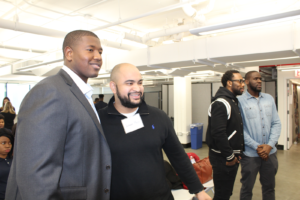Teacher Effectiveness – A Race to Nowhere Redux (The Urgency of Now)

By: Alvin Crawford
Two years ago I wrote a column about the misguided emphasis of the Teacher Effectiveness and Accountability movements. I highlighted the fact that, in America, we focus on measurement rather the systemic changes required to support teachers in becoming effective at reaching all students in a more rigorous college-and-career-ready-standards environment. Sadly, it feels like we’re on an endless treadmill. Little has changed in these past two years, and the need for change holds true.
Elizabeth Green’s NY Times Magazine article, “Why Do Americans Stink at Math?,” and her new book point out how we, as a country, have failed at the implementation of developing effective teachers. Green uses the example of Japan, who imported great teaching methods from the U.S., but implemented them with fidelity—which resulted in a transformation in teaching practice, and ultimately, math scores. Meanwhile in the U.S., the new methods have never gained traction due to poor implementation. While I’m excited about the way Green conveys her knowledge of the material and lessons learned, the underlying theme is not new, as the works of Linda Darling Hammond, Cheryl Desimone, and the folks from Learning Forward, who have studied and reported on this issue for nearly a decade, show. Stephanie Hirsh, Learning Forward Executive Director has stated, “While there is more than enough knowledge about what constitutes highly effective professional development and how to engage educators in it, too few states and school districts act consistently on what is known.”
That said, if we are going to ever ensure, as a nation, that there are career-teachers who will be able to prepare ALL students for globally competitive college and careers in our knowledge worker economy, we must act on what we know, now.
Why is this so important now? I thought that the message was clear ten years ago in Thomas L. Friedman’s book, The World Is Flat: America is falling behind in the Knowledge Economy. Friedman clearly lays the case for us to supersize our education efforts to promote a greater outcome for the U.S. and its competitiveness around the world. In fact, it highlighted several countries that rose to the occasion and demonstrated not just the leadership and will, but also sound approaches to transforming teaching and learning.
We continue to grapple with these issues, but have addressed a couple of things with the Obama administration’s Race to the Top (RTTT). RTTT used a $4.35 Billion carrot to incentivize states to adopt higher standards (the Common Core), require annual teacher evaluations tied to student achievement (billed as Great Teachers, Great Leaders), implement data systems, and provide extra support and an overhaul for struggling schools (the Lowest 1,300). Yet, the greater emphasis was on the accountability components rather than building systems of supports for teachers.
Accountability measures abound. States have established requirements to evaluate teachers and provide consequences–from remediation of teachers to dismissal. New high-stakes assessments have been instituted across the country using PAARC, Smarter Balanced, AIR or an Anti-Common Core Assessment, only racking up significant costs and fear from parents who believe the outcome of these assessments will negatively impact their brilliant children. However, I don’t view these as impactful solutions to our problems. As we saw with No Child Left Behind, accountability alone doesn’t fundamentally change the problem. It just measures it through a different lens.
How do we systemically attack our challenges that have to do with educational equity for all students? How do we build strong teachers and leaders so that they are able to help students prepare for rigorous expectations for college and careers? I see one solution we can implement without fundamentally spending more money: allocate existing dollars towards better and more sustainable outcomes. This approach will require some rethinking and retooling of some antiquated processes and technology. It’s time to consider a new avenue.
Districts need to take responsibility for building systems of support for teachers and principals. And we need accountability placed on districts to overhaul professional development to actually impact instructional practices. According to the research, less than 1% of PD today impacts student achievement, and we spend ridiculous amounts of money on the traditional lecture/workshop-style professional development favored by school districts. We preach blended learning for kids, so why not begin to think about blended professional learning for teachers and principals? These blended learning scenarios can address not only the needs for more intensive acquisition of knowledge and skills, but they can also support teachers’ ongoing, informal knowledge sharing and virtual learning communities of fellow connected educators.
The new models should leverage online solutions for both knowledge acquisition and collaboration with colleagues and onsite coaches to model, mentor, and provide feedback on making the transition from knowledge to practice. We need to systemically build deeper, strategic support for teachers and leaders in four critical areas–
- Early Childhood Education – This is where the gaps begin between the privileged and the left behind.
- Teaching ALL students – Helping all teachers gain mastery in the areas of equity, cultural competence, inclusion, and support for English Language Learners. This has not been treated as a priority at a system level in school districts, and it has perpetuated the achievement gap.
- Common Core and other college and career ready standards – These are fundamental shifts in the way that teachers teach students. We need to go deep in helping teachers understand the new standards, the foundational shifts, and the necessary pedagogies with regard to student engagement and critical thinking.
- Personalized Learning (1:1) – Since everyone is investing in pervasive environments, if we’re really serious about moving to device-enabled learning, then we need to invest significantly in helping teachers understand how to teach in these environments using flipped, blended, and inquiry-based models. One-day workshops won’t get us there.
- These efforts should engage higher-education partners where they are willing and able to work with districts to create career ladders and a sustained support network.
- And finally, over the next several years, I would recommend using assessments to benchmark school systems’ progress towards effective implementation. Until districts can actually support teaching and learning, accountability belongs at the budgetary manager level rather than the teacher.
How will this solve our problem?
- By improving early childhood education for all children, we can end the preschool to prison pipeline and prepare all children for lifelong learning.
- By increasing teacher and leader capacity, we’ll build a permanent workforce that can teach critical thinking, creativity, and collaboration within the content domains.
- We will increase the number of qualified people going into teaching because it is supported and respected systemically.
So far our education reforms have been a race to nowhere. If we turn our frontline (teachers) into the starting line, and begin by supporting them, the U.S. might actually finish first when it comes to student achievement, but the time to start is now.
Alvin Crawford is CEO of Knowledge Delivery Systems, the largest provider of online teacher professional development programs and has been in the teacher training space for close to 20 years.







0 Comments
Leave a Comment
Your email address will not be published. All fields are required.